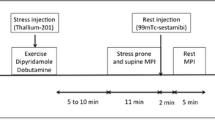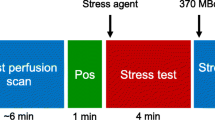Abstract
This study was undertaken to assess the diagnostic value of resting123I-BMIPP scintigraphy in patients with effort angina pectoris. One hundred and four patients underwent scintigraphic and angiographic examinations. The subsets of the patients were stable effort angina pectoris (stable type) in 27 cases, new onset of effort angina pectoris (new onset type) in 21 cases, and worsening effort angina pectoris (worsening type) in 35 cases. The remaining 21 cases were subjects without evidences of coronary artery disease (non-CAD).l23I-BMIPP was injected under resting and pain free condition, then data for single photon emission tomography (SPECT) were acquired. The positive regional123I-BMIPP defects in three coronary territories were visually judged on the tomographic images. The overall sensitivity to diagnose the patients was 62.6% (52/83) and the overall specificity to exclude non-CAD subjects was 95.2% (20/21). The detection rate in each subset of the disease was 48.1% (13/27) in stable type, 47.6% (10/21) in new onset type and 77.1% (27/35) in worsening type (p < 0.05 versus two other types). For detection of stenosed vessels, the overall sensitivity was 41.4% (56/148) and the overall specificity was 93.8% (152/164). The rate of detection of stenosed vessels was 31.7% (13/41) in stable type, 31.4% (11/35) in new onset type, and 55.6% (40/72) in worsening type (p < 0.05 versus two other types). Vessels with 75% stenosis were more sensitively detected in the worsening type (33.3%; 4/12) compared to the remaining two types (8.3%; 1/12) even though the difference was not significant. The resting123I-BMIPP scintigraphy was therefore valuable in diagnosing patients with effort angina pectoris and involved coronary arteries especially in the subset of patients with worsening type.
Similar content being viewed by others
References
Neely JR, Rovetto MJ, Oram JF. Myocardial utilization of carbohydrate and lipids.Prog Cardiovasc Dis 15: 685–698, 1972.
Schon HR, Schelbert HR, Najafi A, Hansen H, Huang H, Barrio J, Phelps ME. C-11 labeled palmitic acid for the non-invasive evaluation of regional myocardial fatty acid metabolism with positron-computed tomography. II. Kinetics of C-11 palmitic acid in acutely ischemic myocardium.Am Heart J 103: 548–561, 1982.
Lerch RA, Ambos HD, Bergmann SR, Welch MJ, Ter-Pogossian MM, Sobel BE. Localization of viable, ischemic myocardium by positron-emission tomography11C palmitate.Circulation 64: 689–699, 1981.
Knapp FF Jr, Kropp J, Goodman MM, Franken P, Reske SN, Ambrose KR, et al. The development of iodine-123-β-methyl branched fatty acids and their applications in nuclear cardiology.Ann Nucl Med 7: SII–1-SII–14, 1993.
Chouraqui P, Maddahi J, Henkin R, Karesh SM, Galie E, Berman DS. Comparison of myocardial imaging with iodine-123-iodophenyl-9-B-methyl pentadecanoic acid and thallium-201-chloride for assessment of patients with exercise-induced myocardial ischemia.J Nucl Med 32: 447–452, 1991.
Tamaki N, Kawamoto M, Yonekura Y, Fujibayashi Y, Takahashi N, Konishi J, et al. Regional metabolic abnormality in relation to perfusion and wall motion in patients with myocardial infarction: Assessment with emission tomography using an iodinated branched fatty acid analog.J Nucl Med 33: 659–667, 1992.
Takeishi Y, Atsumi H, Fujiwara S, Tomoike H. Delayed metabolic recovery of hibernating myocardium after percutaneous transluminal coronary angioplasty: Assessment with iodine-123-β-methyl-p-iodophenyl pentadecanoic acid imaging.J Cardiol 28: 17–25, 1996.
Saitoh M, Hasegawa K, Kondoh T, Yanagawa T. Detection of coronary artery disease using 12-lead electrocardiogram and simultaneous dual myocardial imaging with iodine-123-β-methyl iodophenyl pentadecanoic acid (BMIPP) and thallium-201 in patients with unstable angina.Internal Med 34: 1064–1070, 1995.
Takeishi Y, Sukekawa H, Saito H, Nishimura S, Shibu T, Sasaki Y, et al. Impaired myocardial fatty acid metabolism detected by123I-BMIPP in patients with unstable angina pectoris: Comparison with perfusion imaging by99mTc-sestamibi.Ann Nucl Med 9: 125–130, 1995.
Nakajima K, Shimizu K, Taki J, Uetani Y, Konishi S, Tonami N, et al. Utility of Iodine-123-BMIPP in the diagnosis and follow-up of vasospastic angina.J Nucl Med 36: 1934–1940, 1995.
Kurata C, Tawarahara K, Taguchi T, Aoshima S, Kobayashi A, Yamazaki N, et al. Myocardial emission computed tomography with iodine-123-labeled β-methyl-blanched fatty acid in patients with hypertrophic cardiomyopathy.J Nucl Med 33: 6–13, 1992.
Hashimoto Y, Yamabe H, Yokoyama M. Myocardial defect detected by123I-BMIPP scintigraphy and left ventricular dysfunction in patients with idiopathic dilated cardiomyopathy.Ann Nucl Med 10: 225–230, 1996.
Takeishi Y, Sukekawa H, Saito H, Nishimura S, Sibu T, Sasaki Y, et al. Clinical significance of decreased myocardial uptake of123I-BMIPP in patients with stable effort angina pectoris.Nucl Med Commun 16: 1002–1008, 1995.
Report of the Joint International Society and Federation of Cardiography/World Health Organization Task Force on Standardization of Clinical Nomenclature: Nomenclature and criteria for diagnosis of ischemic heart disease.Circulation 59: 607–609, 1979.
Austen WG, Edwards JE, Frye RL, Gensini GG, Gott VL, Griffith CS, et al. A reporting system on patients evaluated for coronary artery disease: report of the ad hoc committee for grading of coronary artery disease, Council on Cardiovascular Surgery. American Heart Association.Circulation 51: 5–40, 1975.
Yamamichi T, Kusuoka H, Morikita K, Shirakami Y, Kurami M, Okano K, et al. Metabolism of iodine-123-BMIPP in perfused rat hearts.J Nucl Med 36: 1043–1050, 1995.
Fujibayashi Y, Yonekura Y, Takemura Y, Wada K, Matsumoto K, Tamaki N, et al. Myocardial accumulation of iodinated beta-methyl-branched fatty acid analog, iodine-125-15-(p-iodophenyl)3-(R,S)methylpentadecanoic acid (BMIPP), in relation to ATP concentration.J Nucl Med 31: 1818–1822, 1990.
Knapp FF Jr, Ambrose KR, Goodmann MM. New radioiodinated methyl-branched fatty acids for cardiac studies.Eur J Nucl Med 12: S39-S44, 1986.
Kennedy PL, Corbett JR, Kulkarni PV, Wolfe CL, Jansen DE, Hansen CL, et al. Iodine 123-phenylpentadecanoic acid myocardial scintigraphy: usefulness in the identification of myocardial ischemia.Circulation 74: 1007–1015, 1986.
Hansen CL, Corbett JR, Pippin JJ, Jansen DE, Kulkarni PV, Ugolin V, et al. Iodine-123 phenylpentadecanoic acid and single photon emission computed tomography in identifying left ventricular regional metabolic abnormalities in patients with coronary heart disease: Comparison with thallium-201 myocardial tomography.J Am Coll Cardiol 12: 78–87, 1988.
Tawarahara K, Kurata C, Taguchi T, Aoshima S, Okayama K, Kobayashi A, et al. Simultaneous dual myocardial imaging with iodine-123-β-methyl iodophenyl-pentadecanoic acid (BMIPP) and thallium-201 in patients with coronary heart disease.Jpn Circ J 58: 107–115, 1994.
Mori T, Hayakawa M, Hattori K, Awano K, Masuda J, Inatome T, et al. Exercise β-methyl iodophenyl pentadecanoic acid (BMIPP) and resting thallium delayed single photon emission computed tomography (SPECT) in the assessment of ischemia and viability.Jpn Circ J 60: 17–26, 1996.
Franken PR, Dendale P, De Geeter F, Demoor D, Bossuyt A, Block P. Prediction of functional outcome after myocardial infarction using BMIPP and Sestamibi scintigraphy.J Nucl Med 37: 718–722, 1996.
Hashimoto A, Nakata T, Tsuchihashi K, Tanaka S, Fujimori K, Iimura O. Postischemic functional recovery and BMIPP uptake after primary percutaneous transluminal coronary angioplasty in acute myocardial infarction.Am J Cardiol 77: 25–30, 1996.
Matsunari I, Saga T, Taki J, Akashi Y, Hirai J, Wakasugi T, et al. Kinetics of iodine-123 BMIPP in patients withprior myocardial infarction: assessment with dynamic rest and stress images compared with stress thallium-201 SPECT.J Nucl Med 35: 1279–1285, 1994.
Ahmed WH, Bittl JA, Braunwald E. Relation between clinical presentation and angiographic findings in unstable angina pectoris, and comparison with that in stable angina.Am J Cardiol 72: 544–550, 1993.
Bilodeau L, Theroux P, Gregoire J, Gagnon D, Arsenault A. Technetium-99m Sestamibi tomography in patients with spontaneous chest pain: Correlations with clinical, electrocardiographic and angiographie findings.J Am Coll Cardiol 18: 1684–1691, 1991.
Varetto T, Cantalupi D, Altieri A, Orlandi C. Emergency room technetium-99m Sestamibi imaging to rule out acute myocardial ischemic events in patients with nondiagnostic electrocardiograms.J Am Coll Cardiol 22: 1804–1808, 1993.
Wackers FJ, Lie KI, Liem KL, Sokole ED, Samson G, Schoot JB, et al. Thallium-201 scintigraphy in unstable angina pectoris.Circulation 57: 738–742, 1978.
Author information
Authors and Affiliations
Rights and permissions
About this article
Cite this article
Yamabe, H., Abe, H., Yokoyama, M. et al. Resting123I-BMIPP scintigraphy in diagnosis of effort angina pectoris with reference to subsets of the disease. Ann Nucl Med 12, 139–144 (1998). https://doi.org/10.1007/BF03164778
Received:
Accepted:
Issue Date:
DOI: https://doi.org/10.1007/BF03164778




